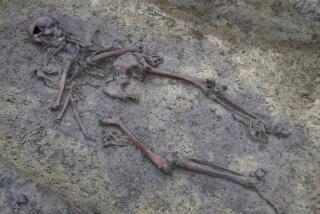Ukrainians Seek Wealth of History in Ancient Graves
VERHNIA KRYNYTSIA, Ukraine — Alla Pleshyvenko points to a fresh pile of soil left by grave robbers on the slopes of a Scythian burial mound.
“They’re looking for gold,” she explains from atop the 22-foot-high knoll known as the First Brother. “They might find some too.”
Then again, they might not. In the 166 years since magnificent gold riches were found in Scythian graves, nearly all the earthen burial mounds, called kurgans, heaped on top of them have been robbed.
But Pleshyvenko and other archeologists value the kurgans not only for the gold and silver missed by treasure hunters--such as the small hoard excavated this summer from a rare undisturbed grave. After nearly 200 years of destructive excavation, they now think that the mounds themselves are as important as what is buried inside.
“These are part of the historical landscape and should be preserved for future generations,” Pleshyvenko says with a wave at the First Brother’s four “sibling” kurgans in this village outside the southern Ukrainian city of Zaporozhye.
Ranging in size from barely noticeable swellings of soil to man-made mountains, tens of thousands of ancient burial mounds rise from the flat steppe north of the Black and Caspian seas like the Egyptian pyramids to which they are often compared.
“The principle of marking graves is the same, except the Egyptians had stone while here in the steppe, there’s soil,” Pleshyvenko explains.
Large kurgans silhouetted against the sky do resemble pyramids, and their symmetry distinguishes them from natural hills and knolls.
While the oldest mounds date back more than 5,000 years, the most famous were left by the Scythians, nomadic warriors who dominated the Ukrainian steppe between 700 BC and 200 BC. Royal Scythian kurgans stood a majestic 60 feet high and also contained sacrificed wives, servants, horses, food and hoards of sumptuous gold and silver jewelry, vases and plates depicting mythological beasts and scenes of Scythian life.
But even the lowliest mounds with no spectacular treasures contain a wealth of information about European prehistory.
“These aren’t just mounds of dirt. They have an architecture,” explains Pleshyvenko, who has excavated more than 100 since 1981.
*
Most kurgans are composite monuments, riddled with many graves and gradually built up over the millenniums by the successive waves of nomads--Cimmerians and Scythians, Goths and Huns, Pechenegs and Cumans--that swept from the east through the Black Sea steppe between 3000 BC and the 13th century.
“The new nomads recognized the mounds left by previous nomads as grave markers and buried their dead in the same places,” Pleshyvenko says. Sometimes they dug graves in existing kurgans, adding fresh soil on top. Or they built entirely new mounds nearby.
Originally, many kurgans also had larger-than-life stone sculptures called babas perched on top like sentries.
Although baba means grandmother, the statues depict both sexes and are believed to represent the ancestors buried beneath or gods and goddesses of the steppe.
“They were clearly objects of reverence,” Pleshyvenko says. “But no one really knows what their purpose was.”
Similar mysteries shroud the people who first built kurgans around 3000 BC. Many scholars in the East and West believe that they invented horseback riding, an innovation soon followed by the appearance of burial mounds across Europe and Asia.
Because the kurgans spread so widely and quickly, the late UCLA archeologist Marija Gimbutas concluded that their builders were the Proto-Indo-Europeans, the hypothetical tribe whose prehistoric migration through Eurasia made their vernacular the common ancestor of Sanskrit, Persian and the majority of European languages.
Widely accepted for years, Gimbutas’ theory was disputed in 1987 by England’s Colin Renfrew, who doubted that the original kurgan builders moved their burial-mound tradition with them. For his carriers of Proto-Indo-European culture, Renfrew looked instead to the undisputed but much older prehistoric migration of Neolithic farmers from the Near East into Europe 8,000 years ago.
The outcome of this debate could depend on the secrets still hidden in the “pyramids of the steppe.”
For example, if the people buried in the earliest kurgans were genetically related to the people buried in later mounds in Central Asia and Western Europe, that would be strong evidence that the kurgan builders migrated, taking their language with them.
*
But according to David Anthony, an anthropologist at New York’s Hartwick College, the mound of genetic material preserved in ancient bones is too small to study using current technologies.
Regardless of the Proto-Indo-European problem, most Ukrainian archeologists think that further kurgan excavations should wait for better times, when they have the money and tools to study them comprehensively.
That’s why they are trying to preserve as many burial mounds as possible from the farm machines, bulldozers--and treasure hunters.
But another reason is reflected in Pleshyvenko’s proud smile when she spots a big, grassy kurgan.
“That one will stand for another thousand years if we leave it alone!” she exclaims.
More to Read
Sign up for Essential California
The most important California stories and recommendations in your inbox every morning.
You may occasionally receive promotional content from the Los Angeles Times.










